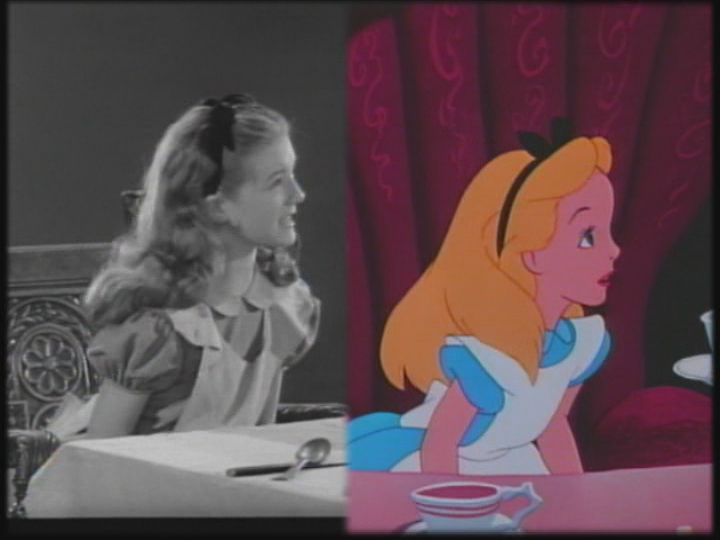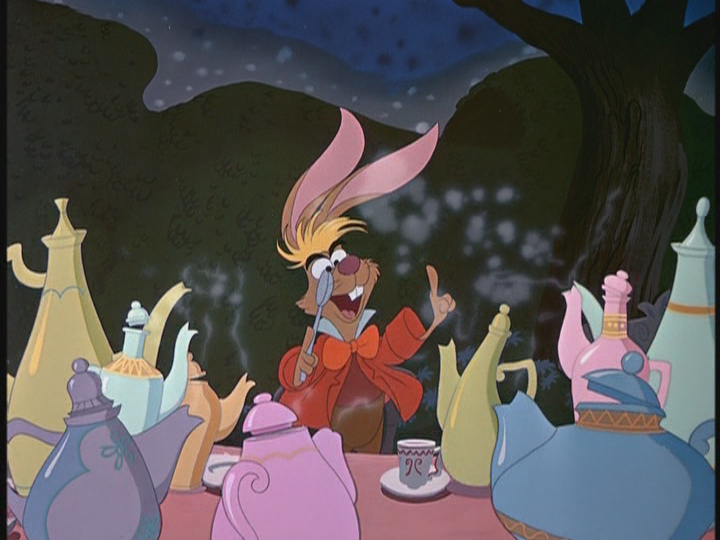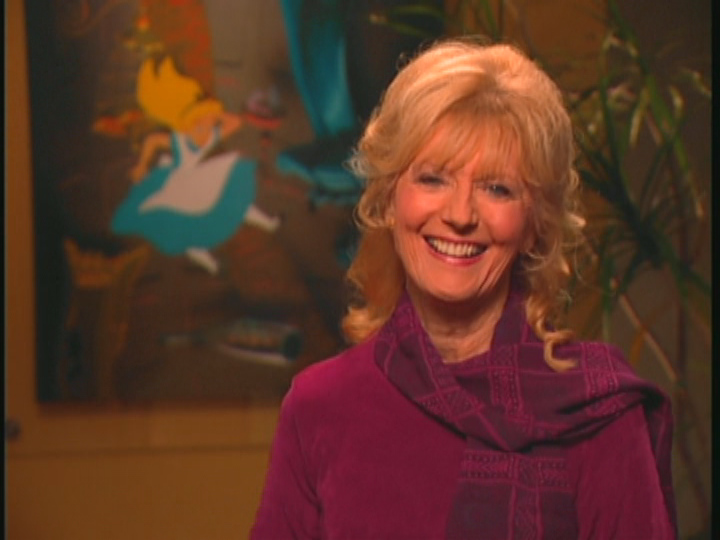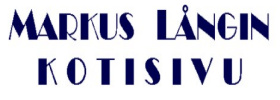© Markus Lång 2006
This review was first published in
Lewis Carroll Review, issue 31
(January 2006), pp. 8–12.
PDF version (1.65 MB)
Alice’s Adventures in Disneyland

|
Alice in Wonderland: The Masterpiece Edition Produced by Walt Disney Adapted from the books of Lewis Carroll Production supervised by Ben Sharpsteen Musical score by Oliver Wallace Directed by Clyde Geronimi, Hamilton Luske and Wilfred Jackson DVD video (2 disks), region 1 Video format: NTSC Audio: English (stereo and mono), French, Spanish Subtitles: English (hard of hearing) Runtime: 75′08″ Buena Vista Home Entertainment 2004, $ 29.99 http://www.disneydvd.com/ |
Walt Disney had always been interested in Lewis Carroll’s Alice books. The animated feature Alice in Wonderland (1951) is his chef-d’œuvre in this respect, but he had been making Alice-entitled silent short films already in the 1920s in which live action is combined with black-and-white animation; this shows how eagerly he always wanted to transcend the inexorable border between reality and fantasy. There is also a Mickey Mouse cartoon from 1936, Thru the Mirror, in which some Carrollian motives appear. These short films show that Disney was not so interested in replicating “exactically” Carroll’s story line but in examining if and how some of his ideas could be applied to animation.
From the early 1930s on, the Disney cartoons developed a distinct and marked animation style, partly dictated by the demands of the animation medium: clear-cut, caricature-like characters, evenly coloured areas and black contours. When one has to draw and colour manually 24 images for a second of film, this is the easiest way to do it; and Walt Disney refined the drawing process to an industry, even planning his studio buildings in Burbank so that the movie in preparation could proceed as if on a conveyor belt. He was the Henry Ford of animated films. Of course, one might suspect that industrial processing is prone to killing creativity, but in the case of the Disney studio, the rationalized and effortless production process left room for story-development and experimentation. During the heyday of hand-drawn animation, the Disney studio produced over forty full-length animated features — from Snow White and the Seven Dwarfs (1937) to Home on the Range (2004). Alice in Wonderland was the thirteenth of them.
The demands of the animated film itself might be an appropriate view-point from which one should approach his feature-length adaptation of the Alice books. Although entitled Alice in Wonderland, the movie combines elements from both of the books. It is probably not among the very best of the animated Disney films, but surely belongs to the best known, and represents the first florescence of the Disney studio, the time before its drawing quality started to deteriorate in the 1960s. Disney’s Alice shows all the strengths of this era: images are vivid and colourful (Disney preferred to use Technicolor film from the early 1930s), animation is effortless and proportional and image compositions balanced. Also the dialogue and music score are polished. This doesn’t however lead to kitsch but grotesque and even scary scenes are encountered as well in dream sequences. (The dance of the Pink Elephants from Dumbo is an unsurpassable example, and something similar can be seen in Alice, too, because it is a dream.) These techniques are used in the service of story-telling and Walt Disney and his collaborators were aiming at stories that would intrinsically be fit for the animated medium. Therefore all his stories — and the use of music, as in Fantasia — are adapted very thoroughly for this new art form and this goes for Alice in Wonderland as well. It was in production almost twenty years, the episodic nature of the books was considered problematic and many solutions were tried.
The opening credits define Alice in Wonderland to be “an adaptation of Lewis Carrol’s [!] The Adventures of Alice in Wonderland and Through the Looking Glass”. This choice of words already makes it apparent that one should not expect a literal or faithful version of the books. Disney’s version could rather be described in musical terms as “a fantasy upon themes of Lewis Carroll”. It is difficult to conceive an adaptation of Alice that would not presuppose any previous knowledge of the story. For instance Percy Stowe’s film version from 1903 does not represent such independence: it merely illustrates the story which is supposed to be familiar to everybody (like movies on Biblical subjects). Disney’s Alice functions better in this respect. The story team took ideas from the Alice books, moulded and combined them in a new way, and added some similar inventions of their own. Only in a very broad scope does the movie follow the basic story: a small girl falls asleep on an English river-bank and dreams of Wonderland where curious incidents take place. Only selected sequences from the book are used, such that are suitable for animated feature. The final product is a work of art that is best judged on its own terms.
Characters from both of the books appear but several others were drafted and later left out as the picture galleries prove. Along with them also many songs were deleted but a few of them are published in this DVD set. Musically one of the most interesting is an abandoned song for the Cheshire Cat, “I’m Odd”.
Compared with some other film versions of Alice, this adaptation has its strengths and weaknesses. First of all one has to say that this version is always a pleasure to watch and to hear. The animation is vivid and detailed and the music score contains swinging songs and movements. Kathryn Beaumont gives a very refined and elegant performance as the voice of Alice. Disney’s Alice character does not much resemble that of John Tenniel but she is a very truthful representation of the young Ms. Beaumont; one can remark this when watching the old publicity materials discussed below. Although this version is of the same length as that of Jonathan Miller (presented in Lewis Carroll Review issue Nº 31), it feels a bit more hurried, as if there were too much material squeezed in 75 minutes. Compared with Nick Willing’s newer version (presented in Lewis Carroll Review issue Nº 23), this is more fluent and entertaining though, far from an episode movie like Make Mine Music (1946).
Quite like Miller’s version also Disney’s Alice is a coherent and happy film and although aesthetically most different they have to be counted among the best film versions of Carroll’s book. Animation makes it possible to actually show many of the Wonderland events, like changes of size, and imaginary characters, anthropomorphic animals and even plants and things, and they are spectacular and surreal in Disney’s version. On the other hand, Miller’s version feels very loyal to the phenomenal nature of the dream, and he doesn’t simplify things like Disney does. Ultimately, the choice belongs to the viewer.
In Disney’s Alice, the original dialogue has been treated and adapted freely and only rarely do we hear direct quotes from the books; when the poems are set to music, they are shortened, like “The Walrus and the Carpenter”. On the other hand, it is the Caterpillar who recites “How Doth the Little Crocodile”, and Tweedledum and Tweedledee are given “Father William”. Changes like this undermine the basic theme of the books, namely Alice’s confusion, but they feel somewhat dream-like.
After having seen a selection of Disney’s propaganda shorts from the World War II released in the DVD set Walt Disney on the Front Lines, one starts to ponder upon whether there be any political undercurrents in Alice in Wonderland, too, which was released after the beginning of the Cold War. The cynical and sinister tone of the cartoon Chicken Little (1943) seems to prevail in the episode “The Walrus and the Carpenter”. One may notice a star, perhaps a star-fish, attached at the behind of the trousers of the Walrus as he begins to lead the oysters to the shore. Curiously enough (as this cannot be a coincidence in a hand-drawn movie) it reminds one of the five-point star present in the flag of the Soviet Union for instance. It feels now very tempting to see the Walrus as I. V. Stalin, the Carpenter as V. I. Lenin and the poor oysters representing East-European and Asian peoples who were lured to embrace Communism, and then consumed to consummation. It is rather difficult to judge if the filmmakers really had such startling intentions in mind but political aspirations were not wholly alien to Walt Disney — think of his movie Victory Through Air Power (1943) for instance.
The animated musical feature is a truly American art form and a genuine contribution to the art of the world. The music score always forms an essential part in Disney cartoons and animated features, especially in the well-known Silly Symphonies. Disney’s Alice in Wonderland is full of music, too, and many scenes follow the rhythm of the music; for example, Tweedledum and Tweedledee make very danceful twins. The enchanting music and catchy songs of the movie belong to the best of Disney films. Although the Mad Tea Party is somewhat too bustled for my taste, I find the song “A Very Merry Un-birthday” quite tuneful. (As Humpty Dumpty does not appear in the movie, the idea of an un-birthday has been given to the Hatter and the March Hare.) The fourteen songs in the movie make it almost a Singspiel.
Compare screenshots from
old and new releases!

|
The new DVD release of 2004 is very high quality and most of the extra features haven’t been seen in decades, some deleted ideas and songs never before. I was able to compare the new U. S. release with an older Scandinavian one (in PAL format) released in 1999, and found the image quality remarkably better. In the older release there are film and video artifacts visible all the time, the image floats a bit and the darker parts of the backgrounds are mere black mess. The new, re-mastered release has a steady, bright image and the backgrounds can be seen. The transfer has obviously been made from a better film print and no video artifacts are present. Especially when watched on a progressive NTSC display, this release provides pure visual delight that only a High-Definition one can surpass.
Originally the movie had a monophonic audio track. The 1999 release had a Dolby Digital 5.0 audio in English; the new one has not only a surround audio in Dolby Digital 5.1 but the original mono track available as well. This is a good decision because a modern surround mix may sound a bit unnatural and anachronous to some viewers. Similar options are available in the new release of Bambi.
The selection of the extra features in this DVD set is moderately interesting. There is no new documentary on the making of the movie but some materials are of historical interest, beginning with the one-reel films Alice’s Wonderland (1923) and Thru the Mirror (1936). On disk Nº 1, there is the deleted song “I’m Odd”, and on disk Nº 2 more unheard songs in old recordings from the 1940s. Two brand-new featurettes on the songs are hosted by Ms. Beaumont. On the other hand, two vintage television shows give an idea of the U. S. promotion of the movie: “One Hour in Wonderland” (actually 59′23″) was Walt Disney’s first television programme, aired on Christmas day 1950 and hosted by Mr. Disney and Ms. Beaumont, with the ventriloquist Edgar Bergen as a guest star; we see excerpts from older classics, including Song of the South, and a glimpse from the forthcoming new movie. More promotion of Alice in an excerpt (30′56″) from The Fred Waring Show, broadcasted on March 18th, 1951, paving the way for the July première. We see Sterling Holloway as the Cheshire Cat, enacting scenes from the movie with some other characters. “Operation Wonderland”, a behind-the-scenes featurette or a trailer (11′08″) from June 1951, shows among other things Ms. Beaumont, Ed Wynn and Jerry Colonna creating the voices of Alice, the Hatter and the March Hare. Also included are theatrical trailers, TV introductions, sing-along songs, and a “Virtual Wonderland Party” on disk Nº 1, which was too fussy and abyssal for me to enjoy. The DVD set includes a card game.
This DVD release is encoded for Region 1 (U. S. A. and Canada) only. In other regions, the Masterpiece Edition contains only one disk and misses most of the extra features that are on disk Nº 2 of the U. S. edition.







